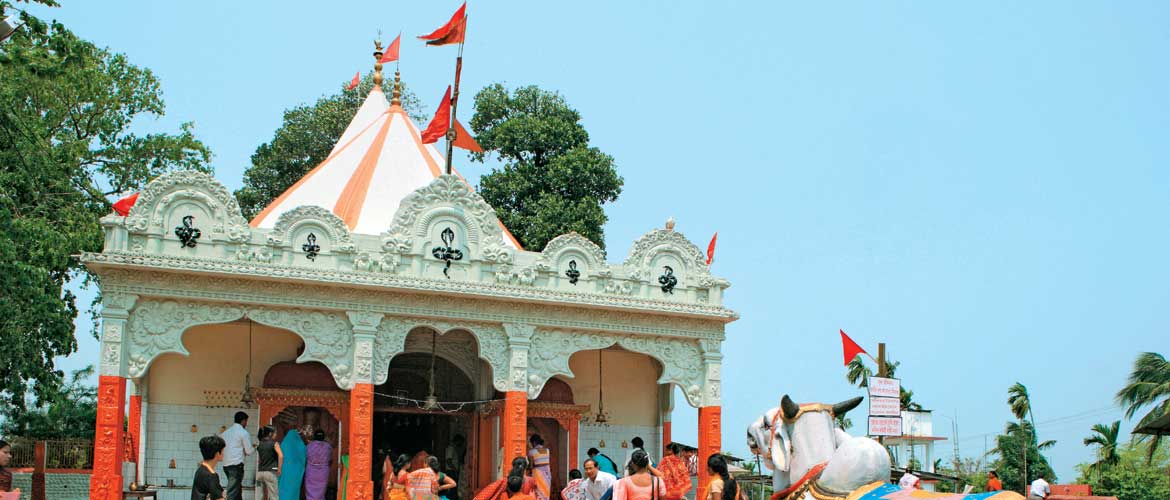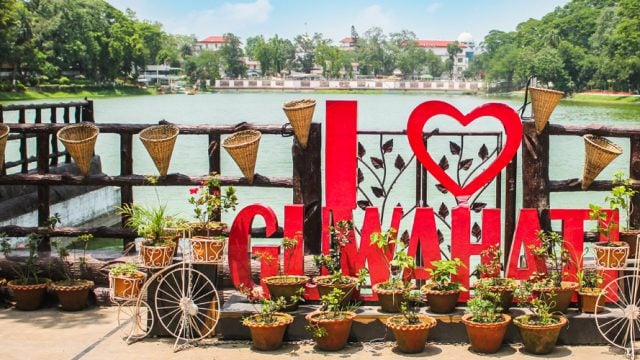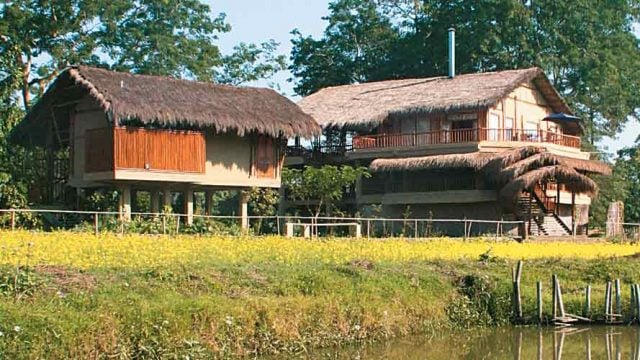Sitting between the snow-capped mountains of the Eastern Himalayas and verdant hills on the north
The new city, which was once the headquarters of the British administration in undivided Assam, is today known for its scenic beauty, verdant parks, pristine lakes, ancient temples and Colonial buildings. It is accepted as the cultural capital of Assam since some of the most famous Assamese people, such as Bishnuprasad Rabha, Jyoti Prasad Agarwala and Bhupen Hazarika have had strong links to the city. Besides being a major com-mercial and administrative centre of north Assam and one of the state’s major tea centres, it is also home to some elite institutions such as the Indian Statistical Institute, the LGB Institute of Mental Health, Tezpur University and the Defence Research Laboratory.

Tezpur’s proximity to the Chinese border makes it especially important for the armed forces, and both the Indian Army and the Air Force have massive bases here. It is also a gateway for travellers heading to Arunachal Pradesh.
LEGENDS AND MYTHOLOGY
As the story goes, Banasura, the king of Sonitpur, had a beautiful daughter called Usha. As tales of her beauty spread, many unsolicited suitors approached Banasura for her hand. But Banasura, who had 1,000 arms and was all-powerful, turned them all away and instead locked Usha in a fort of fire – Agnigarh. An imprisoned Usha dreamt of a young man and fell in love with him. She narrated her predicament to her friend Chitralekha, who found the man of her friend’s dreams. The young man happened to be Lord Krishna’s grandson, Aniruddha. Chitralekha transported a sleeping Aniruddha to the fort where he married Usha. Banasura found out about this and imprisoned Aniruddha. Hearing about the confinement of his grandson, an enraged Lord Krishna attacked the fort. Realizing that he was no match for Krishna’s army, Banasura, a devotee of Shiva, ran to him for help. What followed was a battle of the titans.
According to the Puranas, the battle left the entire kingdom drenched in blood; as a result of which the region came to be known as Tezpur (city of blood). Ultimately, when Krishna’s forces were nearing victory, Shiva intervened because of the promise he had made to Banasura to protect him. Krishna agreed to spare his life, but left Banasura with only four arms to limit his power. A grateful Banasura then released Aniruddha and Usha, and they left for Lord Krishna’s land, Dwarka.

THINGS TO SEE AND DO
Many tourists use this city as an entry point to Arunachal Pradesh. This is a shame, as to overlook Tezpur’s charms means missing out on a plethora of attractions. The city is warm and welcoming, and you can easily spend a week here, exploring its ancient ruins, pretty parks and architecture.
Temples and Ruins
Tezpur has several ancient temples and archaeological ruins in and around the city. The most famous is the Mahabhairab Shiva Temple, which was built by Banasura and is believed to date back to the age of the Mahabharata. The original temple is said to have been made of stone, though the current one is a concrete edifice. Every year there is a fair held in the week of Shivaratri, and pilgrims from all over Assam and neighbouring states throng the temple. The Holeswar Temple, also dedicated to Shiva, is said to date from the 18th century. It sits in a very pretty, serene complex with a water tank.
Bhairabi Temple dedicated to Goddess Durga, is another place of both religious and historical significance. It is said that Usha, Banasura’s daughter often came to worship here.
Tezpur’s claim of being a city of some antiquity is corroborated by several ruins here dating earlier than the 6th century CE. Unmissable amongst these are Parbatia Gate and Bamuni Hills, both now under the aegis of the ASI. The temple ruins of Parbatia are dedicated to Shiva and Vishnu and are one of the earliest specimens of architecture and stone carving in Assam. The stone door-frame unearthed at this site has the characteristic style of the early Gupta period and is the most intricate and oldest specimen of sculptural art in Assam. Bamuni Hills belong to a group of seven shrines that were similarly dedicated to different Hindu gods. There are stunning carvings and ruins here, which make for excellent photo opportunities.
Parks and Lakes
Tezpur boasts some of the most scenic parks and lakes in Assam. The most famous is Agnigarh. Once a mythical jail, present-day Agnigarh is a hill on the banks of the Brahmaputra, and is again one of the most popular tourist attractions in Tezpur. There is a circular stairway leading up to the crest of the hill where there are now sculptures depicting Usha’s abduction of Aniruddha, the grandson of Krishna, and the ensuing battle to free them. From the top of the hill there is a spectacular bird’s-eye view of Tezpur city on one side and the mighty Brahmaputra on the other.

The Chitralekha Udyan, formerly known as Cole Park was originally laid by the British administration in 1906. After independence, it was renamed Chitralekha, after Princess Usha’s friend in the legend of Tezpur. This lovely park has a pristine lake, and there are paddleboats and rowboats on hire for tourists. Children will enjoy the small amusement park and the model of a jet fighter Valiant MIG 21, the first supersonic aircraft of the Indian Air Force.
The park also has several ancient stone artefacts, such as carved pillars and statues. The most famous one amongst these, however, is the Bhomarugiri inscription, an ancient plan for building a bridge across the Brahmaputra river.
Not far from Chitralekha Udyan lies Padum Pukhuri – a large lake set amidst manicured gardens. This park is a major pull for families, as it has a toy train for children and a musical fountain show in the evenings. Padum Pukhuri is also a great place to see migratory birds during winter. Hazra Pukhuri is another lovely lake.
If you enjoy walking, consider going up the hill where Kanaklata Udyan is located. It is named after Kanaklata Baruah, the freedom fighter who lost her life in 1942 during India’s struggle for Independence. There is a statue of her in the park. The place is small, but the climb will be worth the effort for the views of Tezpur city from this vantage point.
Historical Walks
Amidst the bustling crowded streets Tezpur still has some quiet lanes with Colonial buildings that invite exploration during pleasant evenings. Head from the Church field area towards the banks of the Brahmaputra. You will first pass the British-era Dak Bungalow (old post office), which now houses the district museum. Just opposite the Dak Bungalow is the old Court Building. Moving further towards the riverbank, you’ll go past the Church of Epiphany, a small white 19th-century edifice built by American missionaries. Beyond it lies The Station Club, the haunt of European tea planters during the pre-independence era. While taking the slope towards the riverbank, you can stop for a while at the old mission compound. This was the erstwhile home of Charles Alexander Bruce, considered the father of the Indian tea industry. End your walk at Ganeshghat at the banks of the Brahmaputra. You can stay awhile here, and if you have the time, stick around to see the beautiful sunset.

Shopping
Local markets in Tezpur are full of little shops selling pretty handicrafts, but if you don’t have time to explore, head to Bamboo Mart by Assam Tourism in Misson Charali. Items made with cane and bamboo, such as baskets, little figurines, pen holders, etc, are the speciality here.
Pickles, preserves, jams and juices made from exotic fruits and vegetables are a must try. You can also get the deadly bhut jolokia, literally, ‘ghost chilly’ once certified by the Guinness Book of World Records as the world’s hottest chilli (in 2007).
WHERE TO STAY & EAT
Hotel KRC Palace (Tel: 03712-222688, 222788; Tariff: ₹2,400–7,000) is perhaps the best hotel in town. Another good hotel is The Fern Residency (Tel: 255503; Tariff: ₹4,300–7,000), a new property offering plenty of facilities. The Tourist Department’s Prashanti Tourist Lodge (Tel: 221016; Tariff: ₹850–950) near ASTC bus stand, is more basic. On the highway, right at the turn to Tezpur, is hotel KF (Tel: 255203, 237526, Cell: 09706080399; Tariff: ₹2,700–4,700) with rooms and suites, as well as a restaurant. Aditya’s Hotel Centre Point (Tel: 232359, 223210, Cell: 09854000108; Tariff: ₹900–2,700) is a good option as well.
Amongst Tezpur’s many restaurants the Baliram Tower in the main bazaar offers a wide variety of snacks. One can enjoy the local street food near Kamrupia Naamghar Lane. Assamese cuisine can be enjoyed in Spring Valley Restaurant, which is situated close to this place. The Assamese thali is a must try. They have another outlet in Parua Charali where one can try the local non-vegetarian delicacies. The Oasis and The Flora restaurants on Jonaki Road serve tasty Indian and Chinese cuisine.
FAST FACTS
When to go Best time to visit is from October to February. Durga Puja time or autumn and Bihu spring time is great to enjoy both nature and festivities. Assam experiences extreme rainfall from May to July
Tourist Office
Tourist Information Office, Tezpur, Tel: 03712-221016, Cell: 09854334080, STD code 03712
GETTING THERE
State Assam
Location This ancient city lies on the northern bank of the Brahmaputra
Distance 177km NE of Guwahati
Route from Guwahati Follow the NH37 to the Samuguri road, turn towards SH3 and take the NH37A towards Tezpur
Air Solanibari Airport, Tezpur (15km/ 30mins). Air India has direct flights from Kolkata and Silchar. Taxis charge ₹500 to the city centre. Shared tempos also available (₹20 per head). The nearest international airport is at Guwahati (180km/ 4hrs), which is well connected to major cities in India. Taxis from Guwahati charge about ₹2,500 for a drop
Rail Nearest railhead: Dekargaon (8km), connected with Guwahati and other cities of the state. Autos are available outside the station up to the city
Road Tezpur is well-connected with Guwahati and other cities of the state by national and state highways Bus ATDC as well as private tourist buses ply regularly to and from Guwahati
Tezpur
City Breaks
OT Getaway Guides





